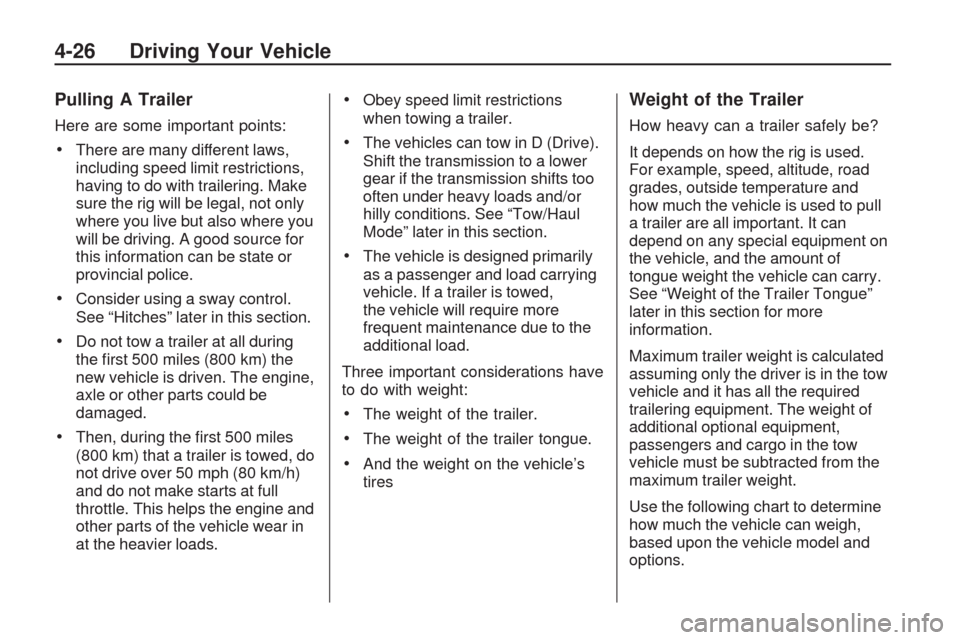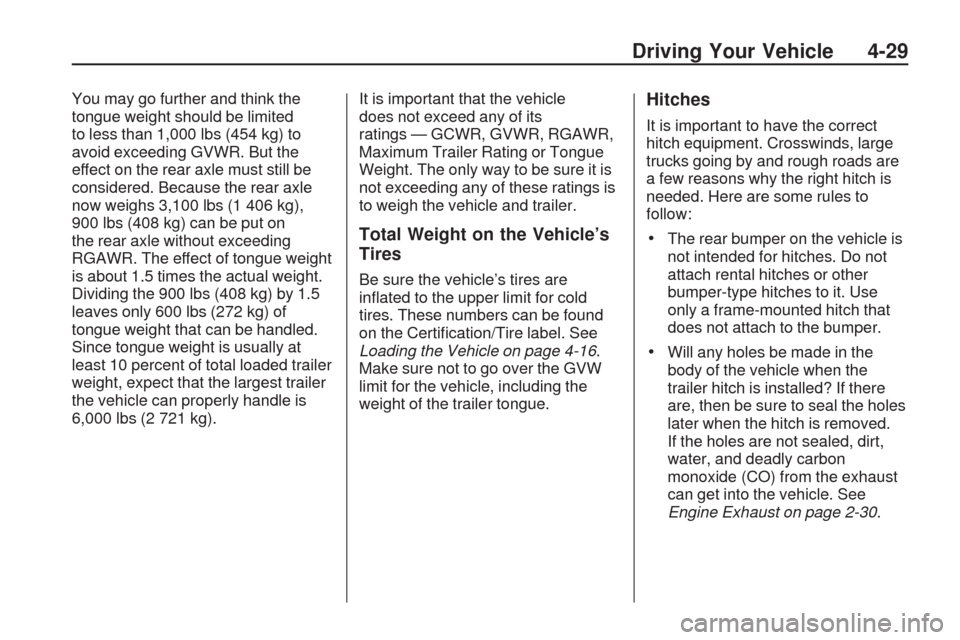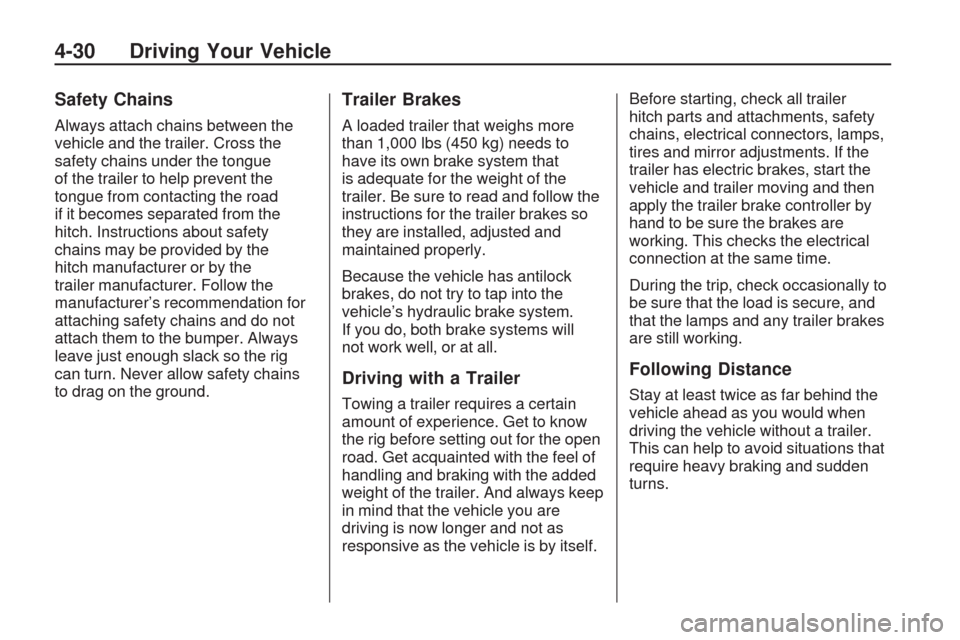2009 CHEVROLET TRAVERSE tires
[x] Cancel search: tiresPage 271 of 422

Notice:If the vehicle is
towed without performing
each of the steps listed under
“Dinghy Towing,” the automatic
transmission could be damaged.
Be sure to follow all steps of the
dinghy towing procedure prior to
and after towing the vehicle.
Notice:If 65 mph (105 km/h) is
exceeded while towing the
vehicle, it could be damaged.
Never exceed 65 mph (105 km/h)
while towing the vehicle.Once the destination is reached:
1. Set the parking brake.
2. Reinstall the 50 amp BATT1 fuse
to the underhood fuse block.
3. Shift the transmission to P (Park),
turn the ignition to LOCK/OFF
and remove the key from
the ignition.
4. Disconnect the vehicle from the
towing vehicle.
Notice:Do not tow a vehicle
with the front drive wheels on the
ground if one of the front tires
is a compact spare tire. Towing
with two different tire sizes on the
front of the vehicle can cause
severe damage to the
transmission.Dolly Towing (All-Wheel-Drive
Vehicles)
All-wheel-drive vehicles must not be
towed with two wheels on the
ground. To properly tow these
vehicles, they should be placed on
a platform trailer with all four
wheels off of the ground or dinghy
towed from the front.
Driving Your Vehicle 4-23
Page 273 of 422

Towing a Trailer
{CAUTION
The driver can lose control when
pulling a trailer if the correct
equipment is not used or the
vehicle is not driven properly. For
example, if the trailer is too heavy,
the brakes may not work well — or
even at all. The driver and
passengers could be seriously
injured. The vehicle may also be
damaged; the resulting repairs
would not be covered by the
vehicle warranty. Pull a trailer only
if all the steps in this section have
been followed. Ask your dealer/
retailer for advice and information
about towing a trailer with the
vehicle.To identify the trailering capacity of
the vehicle, read the information
in “Weight of the Trailer” that
appears later in this section.
Trailering is different than just driving
the vehicle by itself. Trailering means
changes in handling, acceleration,
braking, durability and fuel economy.
Successful, safe trailering takes
correct equipment, and it has to be
used properly.
The following information has many
time-tested, important trailering tips
and safety rules. Many of these are
important for the safety of the driver
and the passengers. So please read
this section carefully before pulling
a trailer.Load-pulling components such as
the engine, transmission, rear axle,
wheel assemblies and tires are
forced to work harder against the
drag of the added weight. The engine
is required to operate at relatively
higher speeds and under greater
loads, generating extra heat. What’s
more, the trailer adds considerably
to wind resistance, increasing the
pulling requirements.
Driving Your Vehicle 4-25
Page 274 of 422

Pulling A Trailer
Here are some important points:
There are many different laws,
including speed limit restrictions,
having to do with trailering. Make
sure the rig will be legal, not only
where you live but also where you
will be driving. A good source for
this information can be state or
provincial police.
Consider using a sway control.
See “Hitches” later in this section.
Do not tow a trailer at all during
the �rst 500 miles (800 km) the
new vehicle is driven. The engine,
axle or other parts could be
damaged.
Then, during the �rst 500 miles
(800 km) that a trailer is towed, do
not drive over 50 mph (80 km/h)
and do not make starts at full
throttle. This helps the engine and
other parts of the vehicle wear in
at the heavier loads.
Obey speed limit restrictions
when towing a trailer.
The vehicles can tow in D (Drive).
Shift the transmission to a lower
gear if the transmission shifts too
often under heavy loads and/or
hilly conditions. See “Tow/Haul
Mode” later in this section.
The vehicle is designed primarily
as a passenger and load carrying
vehicle. If a trailer is towed,
the vehicle will require more
frequent maintenance due to the
additional load.
Three important considerations have
to do with weight:
The weight of the trailer.
The weight of the trailer tongue.
And the weight on the vehicle’s
tires
Weight of the Trailer
How heavy can a trailer safely be?
It depends on how the rig is used.
For example, speed, altitude, road
grades, outside temperature and
how much the vehicle is used to pull
a trailer are all important. It can
depend on any special equipment on
the vehicle, and the amount of
tongue weight the vehicle can carry.
See “Weight of the Trailer Tongue”
later in this section for more
information.
Maximum trailer weight is calculated
assuming only the driver is in the tow
vehicle and it has all the required
trailering equipment. The weight of
additional optional equipment,
passengers and cargo in the tow
vehicle must be subtracted from the
maximum trailer weight.
Use the following chart to determine
how much the vehicle can weigh,
based upon the vehicle model and
options.
4-26 Driving Your Vehicle
Page 277 of 422

You may go further and think the
tongue weight should be limited
to less than 1,000 lbs (454 kg) to
avoid exceeding GVWR. But the
effect on the rear axle must still be
considered. Because the rear axle
now weighs 3,100 lbs (1 406 kg),
900 lbs (408 kg) can be put on
the rear axle without exceeding
RGAWR. The effect of tongue weight
is about 1.5 times the actual weight.
Dividing the 900 lbs (408 kg) by 1.5
leaves only 600 lbs (272 kg) of
tongue weight that can be handled.
Since tongue weight is usually at
least 10 percent of total loaded trailer
weight, expect that the largest trailer
the vehicle can properly handle is
6,000 lbs (2 721 kg).It is important that the vehicle
does not exceed any of its
ratings — GCWR, GVWR, RGAWR,
Maximum Trailer Rating or Tongue
Weight. The only way to be sure it is
not exceeding any of these ratings is
to weigh the vehicle and trailer.
Total Weight on the Vehicle’s
Tires
Be sure the vehicle’s tires are
in�ated to the upper limit for cold
tires. These numbers can be found
on the Certi�cation/Tire label. See
Loading the Vehicle on page 4-16.
Make sure not to go over the GVW
limit for the vehicle, including the
weight of the trailer tongue.
Hitches
It is important to have the correct
hitch equipment. Crosswinds, large
trucks going by and rough roads are
a few reasons why the right hitch is
needed. Here are some rules to
follow:
The rear bumper on the vehicle is
not intended for hitches. Do not
attach rental hitches or other
bumper-type hitches to it. Use
only a frame-mounted hitch that
does not attach to the bumper.
Will any holes be made in the
body of the vehicle when the
trailer hitch is installed? If there
are, then be sure to seal the holes
later when the hitch is removed.
If the holes are not sealed, dirt,
water, and deadly carbon
monoxide (CO) from the exhaust
can get into the vehicle. See
Engine Exhaust on page 2-30.
Driving Your Vehicle 4-29
Page 278 of 422

Safety Chains
Always attach chains between the
vehicle and the trailer. Cross the
safety chains under the tongue
of the trailer to help prevent the
tongue from contacting the road
if it becomes separated from the
hitch. Instructions about safety
chains may be provided by the
hitch manufacturer or by the
trailer manufacturer. Follow the
manufacturer’s recommendation for
attaching safety chains and do not
attach them to the bumper. Always
leave just enough slack so the rig
can turn. Never allow safety chains
to drag on the ground.
Trailer Brakes
A loaded trailer that weighs more
than 1,000 lbs (450 kg) needs to
have its own brake system that
is adequate for the weight of the
trailer. Be sure to read and follow the
instructions for the trailer brakes so
they are installed, adjusted and
maintained properly.
Because the vehicle has antilock
brakes, do not try to tap into the
vehicle’s hydraulic brake system.
If you do, both brake systems will
not work well, or at all.
Driving with a Trailer
Towing a trailer requires a certain
amount of experience. Get to know
the rig before setting out for the open
road. Get acquainted with the feel of
handling and braking with the added
weight of the trailer. And always keep
in mind that the vehicle you are
driving is now longer and not as
responsive as the vehicle is by itself.Before starting, check all trailer
hitch parts and attachments, safety
chains, electrical connectors, lamps,
tires and mirror adjustments. If the
trailer has electric brakes, start the
vehicle and trailer moving and then
apply the trailer brake controller by
hand to be sure the brakes are
working. This checks the electrical
connection at the same time.
During the trip, check occasionally to
be sure that the load is secure, and
that the lamps and any trailer brakes
are still working.
Following Distance
Stay at least twice as far behind the
vehicle ahead as you would when
driving the vehicle without a trailer.
This can help to avoid situations that
require heavy braking and sudden
turns.
4-30 Driving Your Vehicle
Page 283 of 422

Service and
Appearance Care
ServiceService................................5-3
Accessories and
Modi�cations.......................5-3
California Proposition 65
Warning.............................5-4
California Perchlorate
Materials Requirements........5-4
Doing Your Own
Service Work......................5-4
Adding Equipment to the
Outside of the Vehicle...........5-4
FuelFuel....................................5-5
Gasoline Octane...................5-5
Gasoline Speci�cations..........5-5
California Fuel......................5-5
Additives..............................5-5
Fuels in Foreign Countries......5-6
Filling the Tank.....................5-7
Filling a Portable Fuel
Container...........................5-8
Checking Things Under
the Hood
Checking Things Under
the Hood............................5-9
Hood Release.......................5-9
Engine Compartment
Overview..........................5-10
Engine Oil..........................5-11
Engine Oil Life System.........5-13
Engine Air Cleaner/Filter.......5-15
Automatic Transmission
Fluid................................5-16
Cooling System...................5-17
Engine Coolant...................5-17
Engine Overheating.............5-22
Overheated
Engine Protection
Operating Mode.................5-23
Power Steering Fluid............5-24
Windshield Washer Fluid......5-24
Brakes...............................5-25
Battery...............................5-28
Jump Starting.....................5-29
Headlamp AimingHeadlamp Aiming................5-33
Bulb ReplacementBulb Replacement...............5-33
Halogen Bulbs....................5-33
Taillamps, Turn Signal,
Stoplamps and
Sidemarker Lamps.............5-33
Replacement Bulbs..............5-34
Windshield Wiper Blade
Replacement
Windshield Wiper Blade
Replacement.....................5-35
TiresTires..................................5-36
Tire Sidewall Labeling..........5-37
Tire Terminology and
De�nitions.........................5-39
In�ation - Tire Pressure........5-42
Tire Pressure Monitor
System.............................5-43
Tire Pressure Monitor
Operation..........................5-45
Tire Inspection and
Rotation............................5-48
When It Is Time for New
Tires................................5-50
Buying New Tires................5-50
Service and Appearance Care 5-1
Page 284 of 422

Different Size Tires and
Wheels.............................5-52
Uniform Tire Quality
Grading............................5-52
Wheel Alignment and Tire
Balance............................5-54
Wheel Replacement.............5-54
Tire Chains.........................5-55
If a Tire Goes Flat...............5-56
Tire Sealant and
Compressor Kit..................5-57
Tire Sealant and
Compressor Kit Storage......5-64
Changing a Flat Tire............5-65
Removing the Spare Tire
and Tools.........................5-66
Removing the Flat Tire
and Installing the
Spare Tire........................5-68
Secondary Latch System......5-72
Storing a Flat or Spare
Tire and Tools...................5-74
Compact Spare Tire.............5-77
Appearance CareInterior Cleaning..................5-78
Fabric/Carpet......................5-79
Leather..............................5-80Instrument Panel, Vinyl,
and Other Plastic
Surfaces...........................5-80
Care of Safety Belts............5-80
Weatherstrips......................5-81
Washing Your Vehicle..........5-81
Cleaning Exterior Lamps/
Lenses.............................5-81
Finish Care.........................5-81
Windshield, Backglass, and
Wiper Blades....................5-82
Aluminum or Chrome-Plated
Wheels and Trim................5-83
Tires..................................5-83
Sheet Metal Damage...........5-84
Finish Damage....................5-84
Underbody Maintenance.......5-84
Chemical Paint Spotting........5-84
Vehicle Identi�cationVehicle Identi�cation
Number (VIN)....................5-85
Service Parts Identi�cation
Label...............................5-85
Electrical SystemHigh Voltage Devices and
Wiring..............................5-85
Add-On Electrical
Equipment........................5-86
Windshield Wiper Fuses.......5-86
Power Windows and Other
Power Options...................5-86
Fuses and Circuit Breakers. . .5-86
Instrument Panel
Fuse Block.......................5-86
Underhood Fuse Block.........5-88
Capacities and Speci�cationsCapacities and
Speci�cations....................5-92
5-2 Service and Appearance Care
Page 309 of 422

Notice:
Using the wrong �uid can badly
damage brake hydraulic system
parts. For example, just a few
drops of mineral-based oil,
such as engine oil, in the brake
hydraulic system can damage
brake hydraulic system parts so
badly that they will have to be
replaced. Do not let someone
put in the wrong kind of �uid.
If brake �uid is spilled on the
vehicle’s painted surfaces, the
paint �nish can be damaged. Be
careful not to spill brake �uid
on the vehicle. If you do, wash it
off immediately. SeeWashing
Your Vehicle on page 5-81.
Brake Wear
This vehicle has disc brakes. Disc
brake pads have built-in wear
indicators that make a high-pitched
warning sound when the brake
pads are worn and new pads are
needed. The sound can come
and go or be heard all the time the
vehicle is moving, except when
applying the brake pedal �rmly.
{CAUTION
The brake wear warning sound
means that soon the brakes will
not work well. That could lead to
an accident. When the brake wear
warning sound is heard, have the
vehicle serviced.
Notice:Continuing to drive with
worn-out brake pads could
result in costly brake repair.Some driving conditions or climates
can cause a brake squeal when the
brakes are �rst applied or lightly
applied. This does not mean
something is wrong with the brakes.
Properly torqued wheel nuts are
necessary to help prevent brake
pulsation. When tires are rotated,
inspect brake pads for wear and
evenly tighten wheel nuts in
the proper sequence to torque
speci�cations inCapacities and
Specifications on page 5-92.
Brake linings should always be
replaced as complete axle sets.
Brake Pedal Travel
See your dealer/retailer if the brake
pedal does not return to normal
height, or if there is a rapid increase
in pedal travel. This could be a sign
that brake service might be required.
Service and Appearance Care 5-27